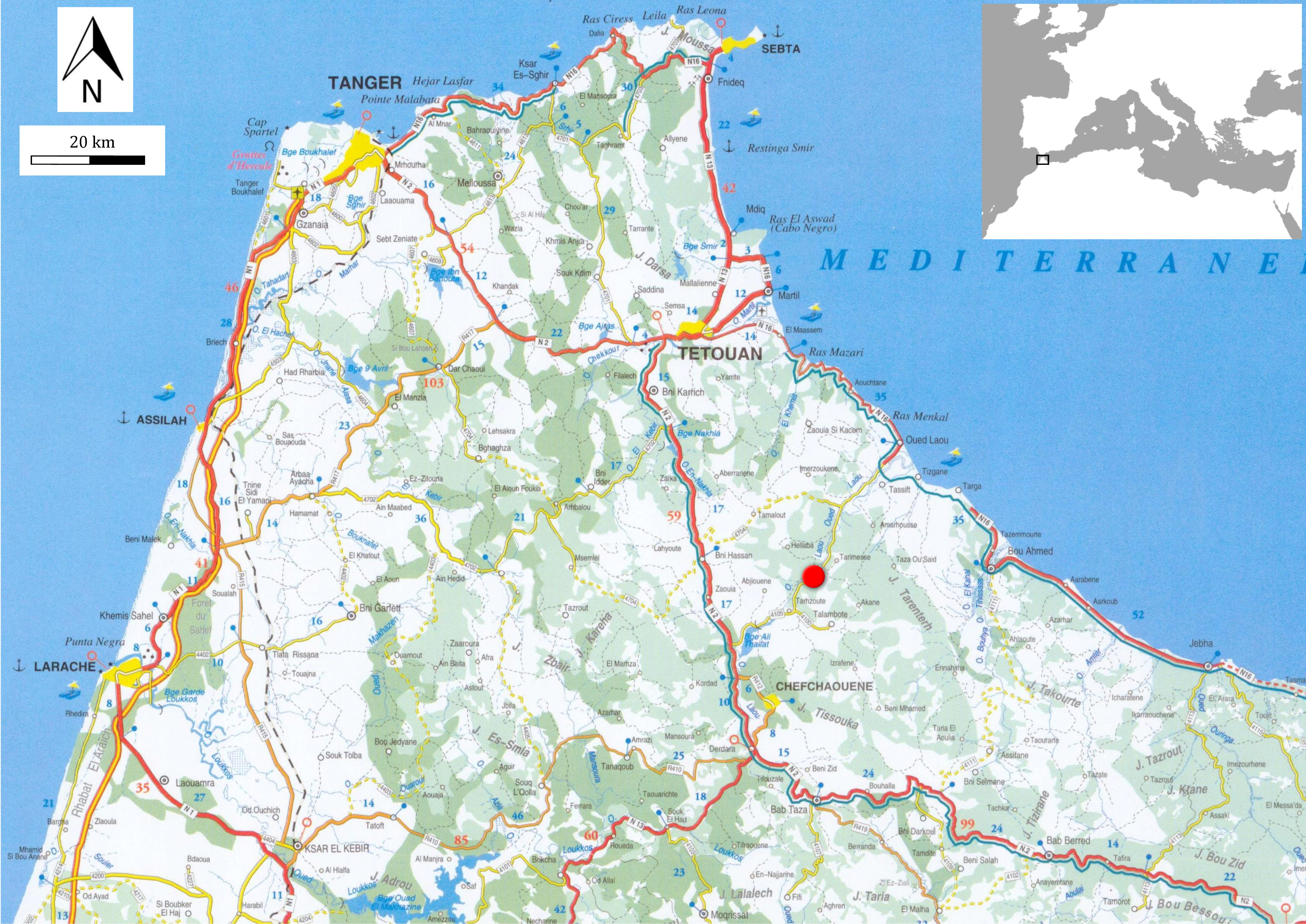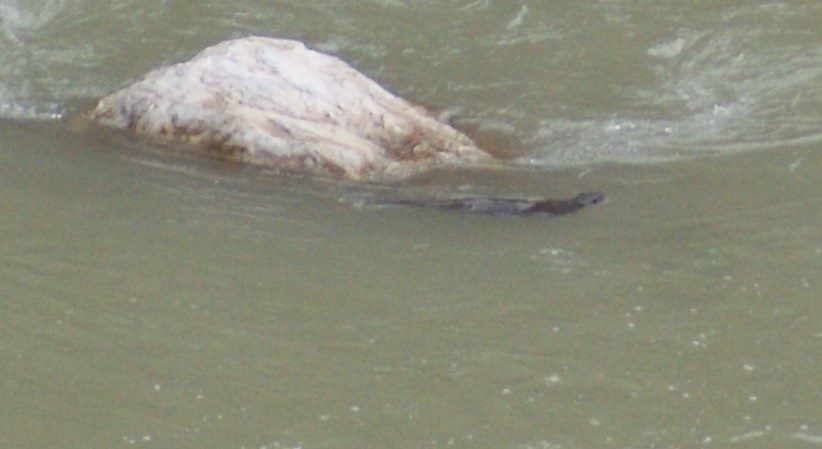IUCN/SSC Otter Specialist Group Bulletin

©IUCN/SCC Otter Specialist Group
Volume 35 Issue 4 (December 2018)
Citation: Waters S and El Harrad, A (2018). New Location for the Eurasian Otter Lutra lutra in the Catchments of the Western Rif Mountains of Morocco. IUCN Otter Spec. Group Bull. 35 (4): 230 - 234
New Location for the Eurasian Otter Lutra lutra in the Catchments of the Western Rif Mountains of Morocco
Sian Waters1* and Ahmed El Harrad
1Barbary Macaque Awareness and Conservation, Tétouan, Morocco.
* Corresponding Author: Email: sianwaters@gmail.com
Received 6th July 2018, accepted 28th August 2018
Abstract: The Eurasian Otter Lutra lutra has experienced a resurgence in Europe attributed to pollution control policies particularly organochlorine pesticides and polychlorinated biphenyls (PCBs). However, little is known about the species’ presence in North Africa. Here, we report the first direct observations of otters in two major rivers in the western Rif Mountains of North Morocco. We made opportunistic observations of otters while surveying and monitoring Barbary Macaques Macaca sylvanus, which inhabit steep river canyons in this area of their distribution. We observed three individual otters in two different rivers confirming the species’ presence in the western Rif. We intend to continue surveying for otter presence and to set camera traps in river canyons when circumstances allow.
Keywords: Eurasian otter, Lutra lutra, Morocco, Rif Mountains
INTRODUCTION
The Eurasian Otter Lutra lutra has Near Threatened status on the IUCN Red List. The species is making a strong recovery in many parts of Europe but its status in Morocco and the rest of its African range is far from clear (Delibes et al., 2012). A survey was conducted in the watersheds of the Middle and High Atlas in 1983 and repeated in 2011 (MacDonald and Mason, 1983; Delibes et al., 2012). The 2011 survey found results similar to those of 1983 with the caveat that the species might be declining on the lowland plains (Delibes et al., 2012). Neither of these surveys investigated the catchments of the western Rif Mountains in the north of Morocco. Here we present what is, to the best of our knowledge, the first documented observation of otters in the Western Rif Mountains.
STUDY SITES
Our study site where we survey and monitor the Endangered Barbary macaque Macaca sylvanus includes the mountainous areas of Bouhachem mixed oak forest, Talessemtane National Park (NP) and its surroundings and the canyons connecting Talessemtane NP to the calcareous massif running south east from Tétouan (Fig. 1). The carnivore species in these areas are not well studied. Local people do not fish for subsistence; they frequent the river canyons only if preparing and cultivating the more accessible areas for cannabis cultivation, so may be unaware of otter presence.
We employ local ecological knowledge to ascertain presence of macaques in what is often steep inhospitable terrain and we then verify the reports by surveying the sites named by participants and recording sight or sign of macaques. Since 2015, we have been working in and around Talessemtane NP and began visiting the steep narrow canyons surrounding the park where local people alerted us to the presence of Barbary Macaques. The macaques feed on the dense riparian vegetation such as that described by MacDonald and Mason (1984) which forms impenetrable thickets along and above the rivers which have water all year round. When we can access the canyon floors, we also check for signs of otter presence such as spraints and tracks.

(click for larger version)
RESULTS
We failed to find any signs of otters in river canyons. However, in August, 2013, AEH observed a single otter on rocks above Oued el Ferda, a tributary of the Oued (= River) Lao. The site is included in Talessemtane NP. The otter was moving quickly and soon disappeared into undergrowth. In April 2018, we were looking for a group of macaques, which frequented that particular part of the canyon of Oued Lao (see Fig. 1). The canyon has little vegetation on its banks at that point (Fig. 2). AEH spotted an otter swimming slowly down river and SW then spotted another some 10 meters behind it. We followed the animals with binoculars as they swam downstream (see Fig. 3). At the point we observed the otters the canyon floor is ~100 m above sea level. Given the time of year it is possible that this was a male and female.
DISCUSSION
MacDonald and Mason (1984) pointed out that the otter’s distribution in Morocco is clearly limited by lack of water. Oued Lao and its tributaries have water all year round and are currently suitable habitat for otters. Given the remoteness of the area, PCBs and other chemicals may not cause major contamination of the watercourses. Our observations of the species provide confirmation of its presence in these catchments and an increase in the species’ known Moroccan range.
We have found no suggestion of conflict between people and otters due to the lack of dependence on river fish by villagers. However, a major threat comes from disturbance from tourist activities, particularly in spring, when hundreds of people crowd into some of the more accessible river canyons. Village dogs kill other carnivores such as the African Wolf (Canis lupus lupaster), Common Genet (Genetta genetta) and Red Fox (Vulpes vulpes) in these areas, so may present a threat to otters. We have recently observed accelerated clearance of vegetation from steep canyon sides for the planting of cannabis and we believe this to be a serious threat to both otters and Barbary Macaques in the canyons.
We are now beginning to focus on other river systems in our study areas. Our inability to find otter sign may be related to the non-systematic way we are searching which we will endeavour to rectify. Additionally, we hope that, with the use of camera traps, we will be able to provide more information on the presence of otters in this area of the Rif and possibly beyond.
Acknowledgements: We thank the Haut Commissariat des Eaux et Forêts et la Lutte Contre le Désertification for granting permission to survey Barbary macaques. We thank Andrew Walmsley for help with the map. We are extremely grateful to: Beauval Nature, France; Association Française des Parcs Zoologiques, France; GaiaZOO, The Netherlands; People’s Trust for Endangered Species, UK; Zoo Vienna, Austria; Conservatoire pour la protection des primates France; Folly Farm, UK; Zoo Helsinki, Finland; Parco Natura Viva, Italy; Blair Drummond Safari Park, UK; NaturZoo Rheine, Germany; Ouwehands Zoo, the Netherlands; Alameda Wildlife Conservation Park, Gibraltar, Woburn Safari Park, UK and many private donors for supporting our research and conservation work. We are very grateful to Will Duckworth for suggesting we write this contribution and for his comments on an earlier version. Grateful thanks to Abdou Nakata Benattabou for the translation of the abstract.
REFERENCES
Delibes, M., Calzado, J., Clavero, M., Fernandez, N., Gutierrez-Exposito, C., Revilla, E., Roman, J. (2012). The near threatened Eurasian Otter (Lutra lutra) in Morocco: No sign of recovery. Oryx 46:249-252.
MacDonald, S.M., Mason, C.F. (1984). Otters in Morocco. Oryx 18:157-159.
Resumé: Nouveau Site pour la Loutre Eurasienne, Lutra lutra, dans les Bassins Versants des Montagnes du Rif Occidental au Maroc
La loutre eurasienne, Lutra lutra, a connu une renaissance en Europe, en raison des politiques de contrôle de la pollution, en particulier des pesticides organochlorés et des polychlorobiphényles (PCBs). Cependant, on sait peu de chose sur la présence de l’espèce en Afrique du Nord. Nous rapportons ici les premières observations directes de loutres dans deux importantes rivières des montagnes du Rif occidental au nord du Maroc. Nous avons effectué des observations providentielles de loutres alors que nous observions et faisions un suivi des Macaques Barbary, Macaca sylvanus, qui habitent des canyons de rivières abruptes dans cette zone de leur aire de répartition. Nous avons observé trois loutres sur deux rivières différentes, confirmant la présence de l’espèce dans le Rif occidental. Nous avons l’intention de continuer le suivi de la présence de loutres et d’installer des pièges photographiques dans les canyons des rivières lorsque les circonstances le permettent.
Revenez au dessus
Resumen: Nueva Localidad para la Nutria Eurasiática Lutra lutra en las Nacientes de Cuenca en las Montañas de los Rif Occidentales, Marruecos
La Nutria Eurasiática Lutra lutra ha experimentado un resurgimiento en Europa, atribuido a las políticas de control de la contaminación, particularmente de los pesticidas organoclorados y los bifenilos policlorados (PCBs). Sin embargo, se sabe poco acerca de la presencia de la especie en el Norte de Africa. Aquí, informamos las primeras observaciones directas de nutrias en dos grandes ríos en las Montañas Rif occidentales del norte de Marruecos. Realizamos observaciones oportunísticas de nutrias mientras prospectábamos y monitoreábamos Macacos de Berbería Macaca sylvanus, que habita en cañadones profundos y abruptos en esta parte de su distribución. Observamos trres nutrias en dos ríos diferentes, confirmando la presencia de la especie en el Rif occidental. Tenemos la intención de continuar prospectando la presencia de nutrias, e instalar cámaras-trampa en los cañadones, cuando las circunstancias lo permitan.
Vuelva a la tapa




